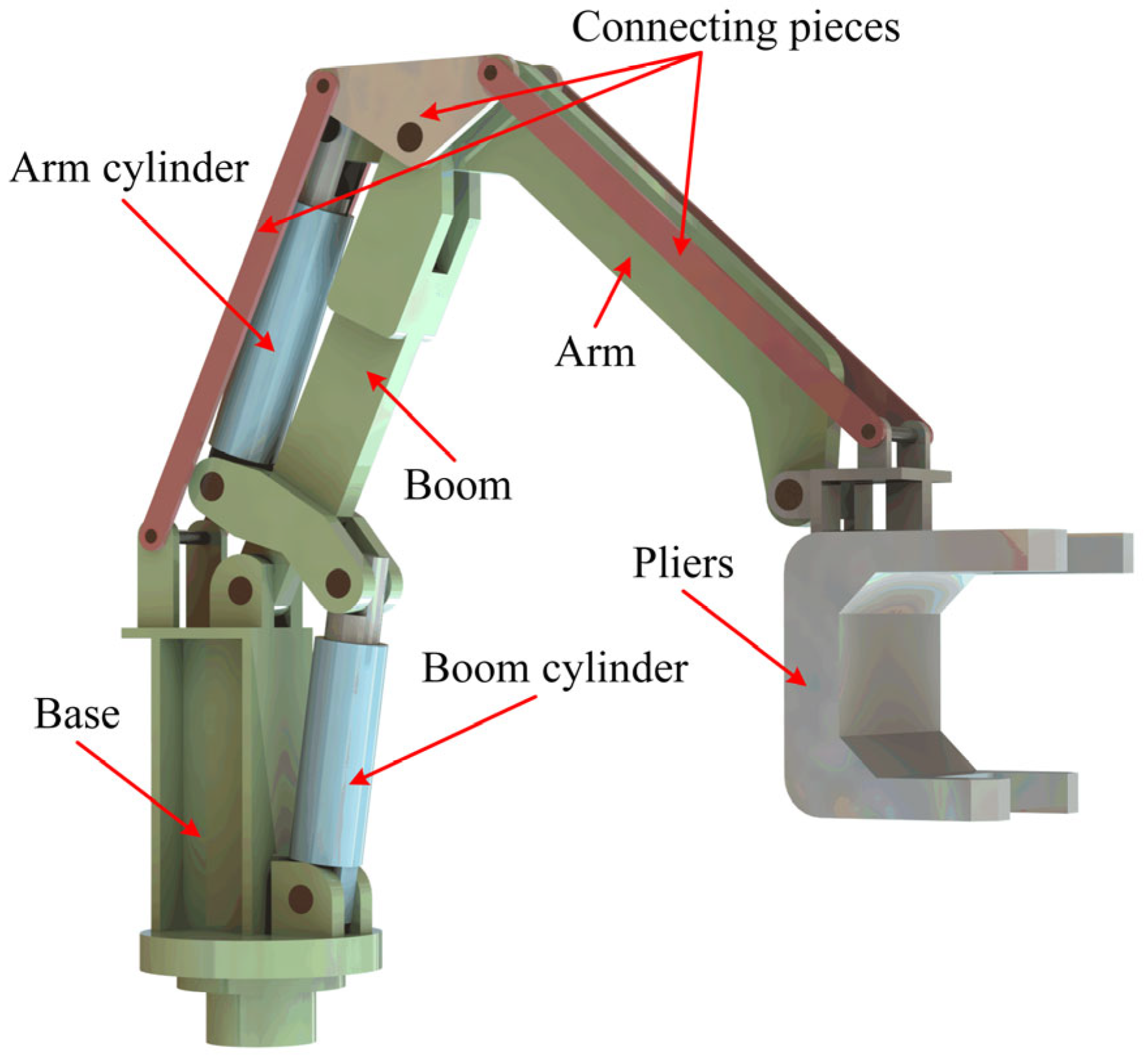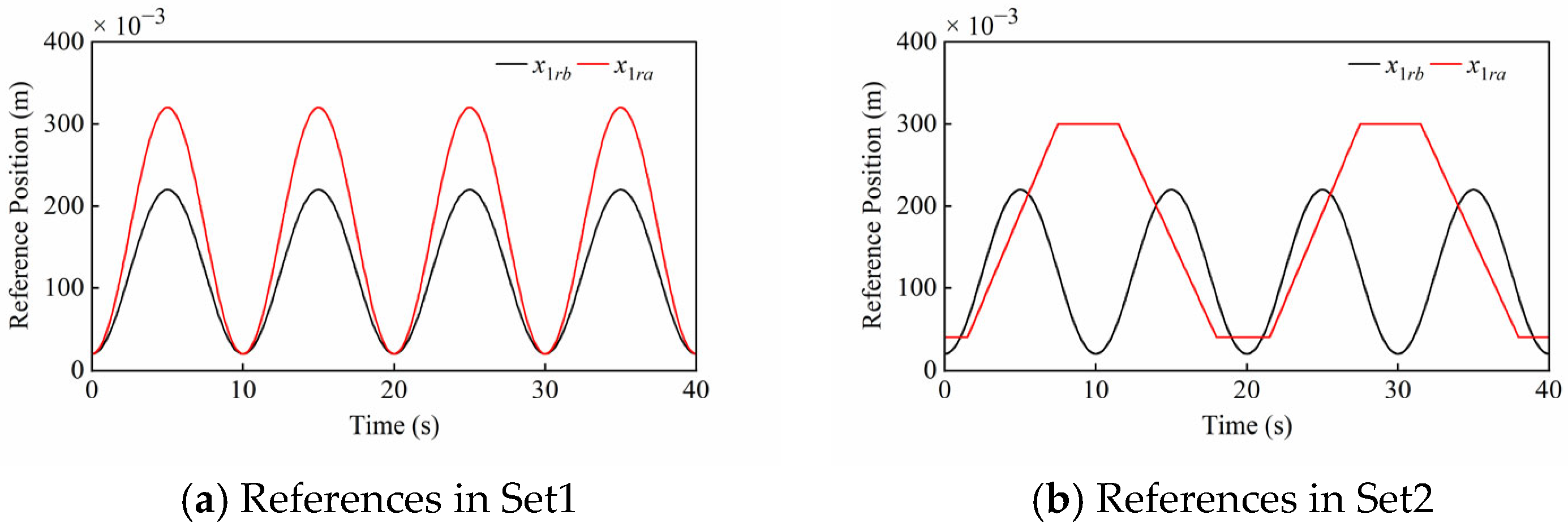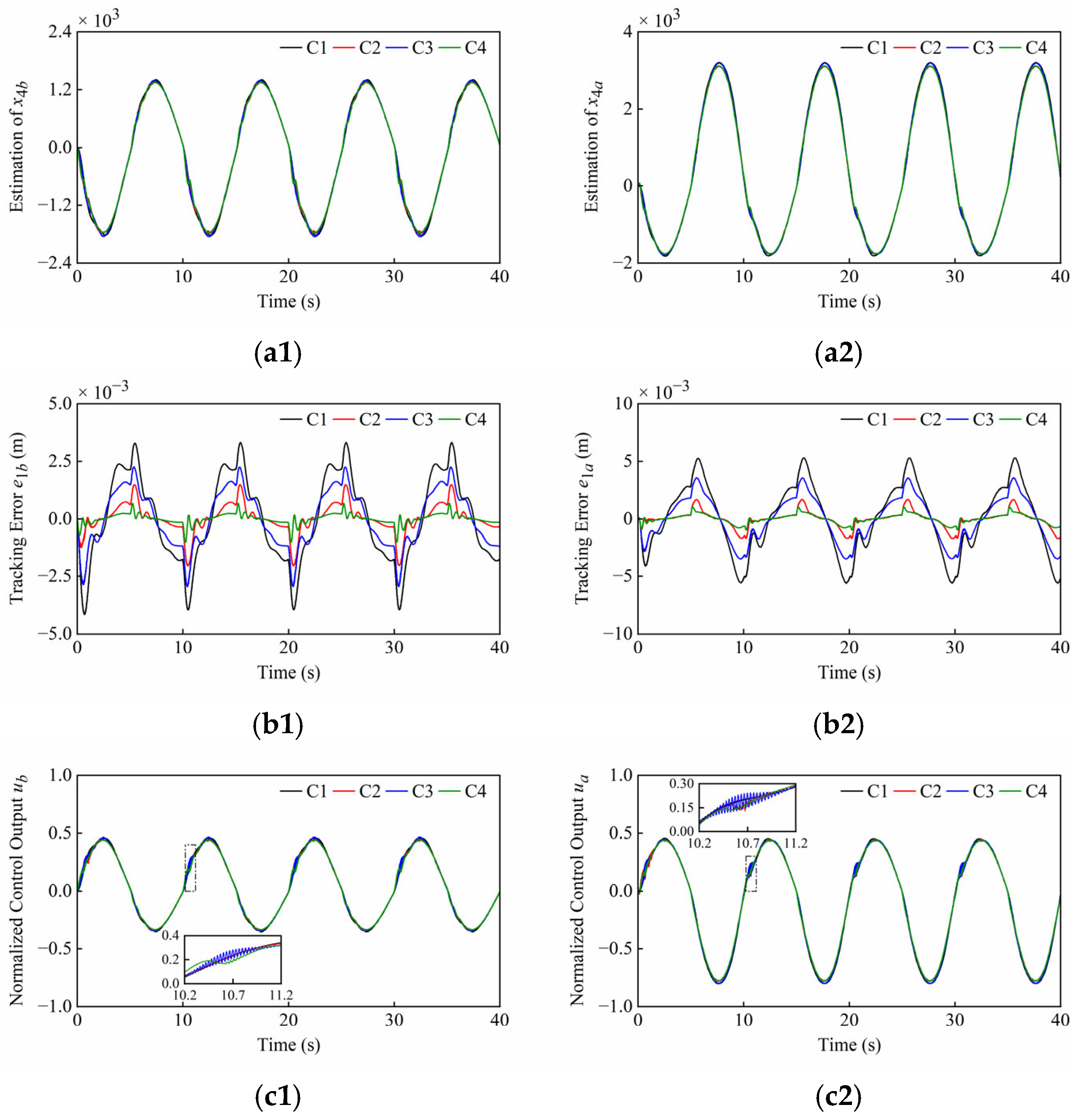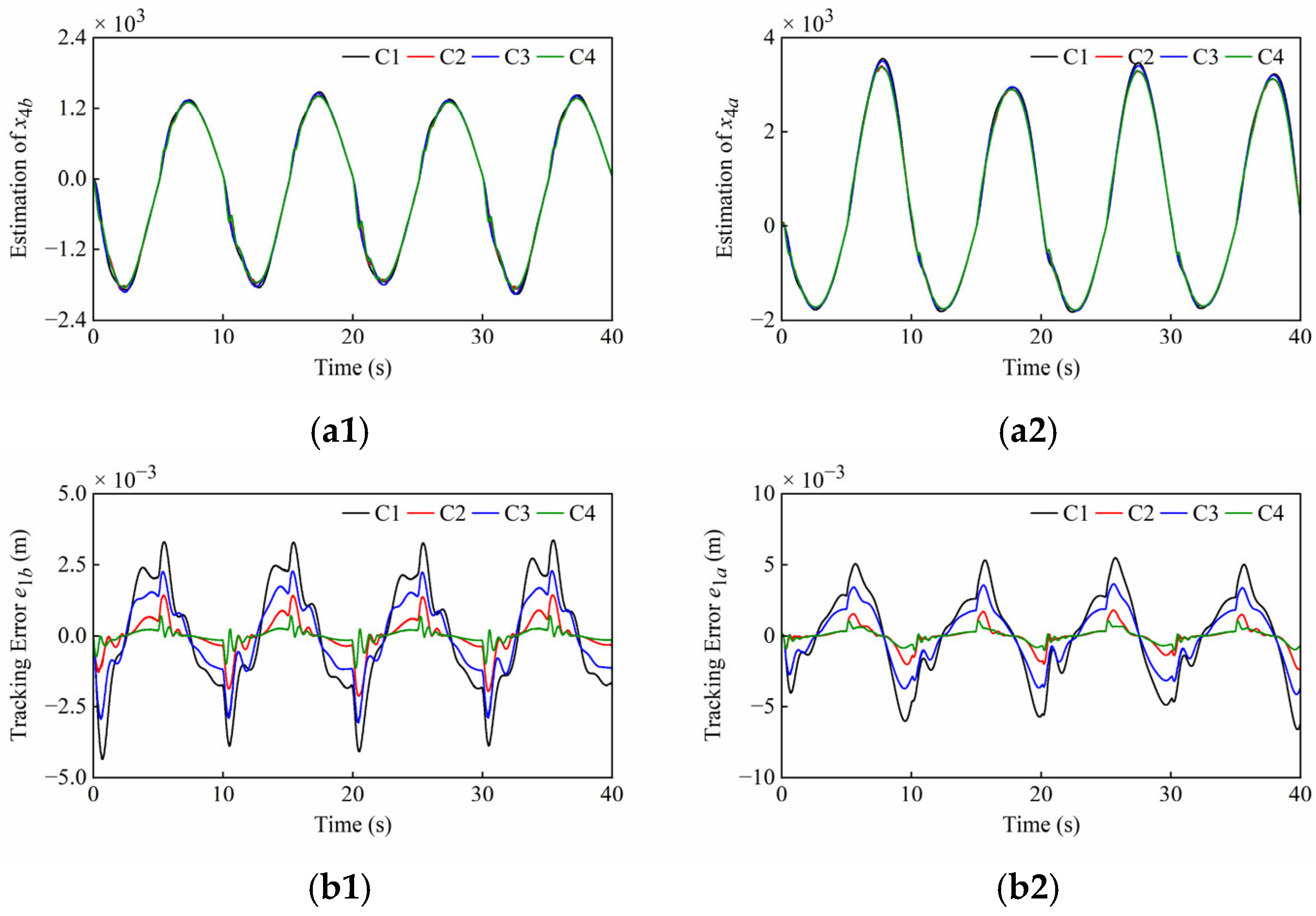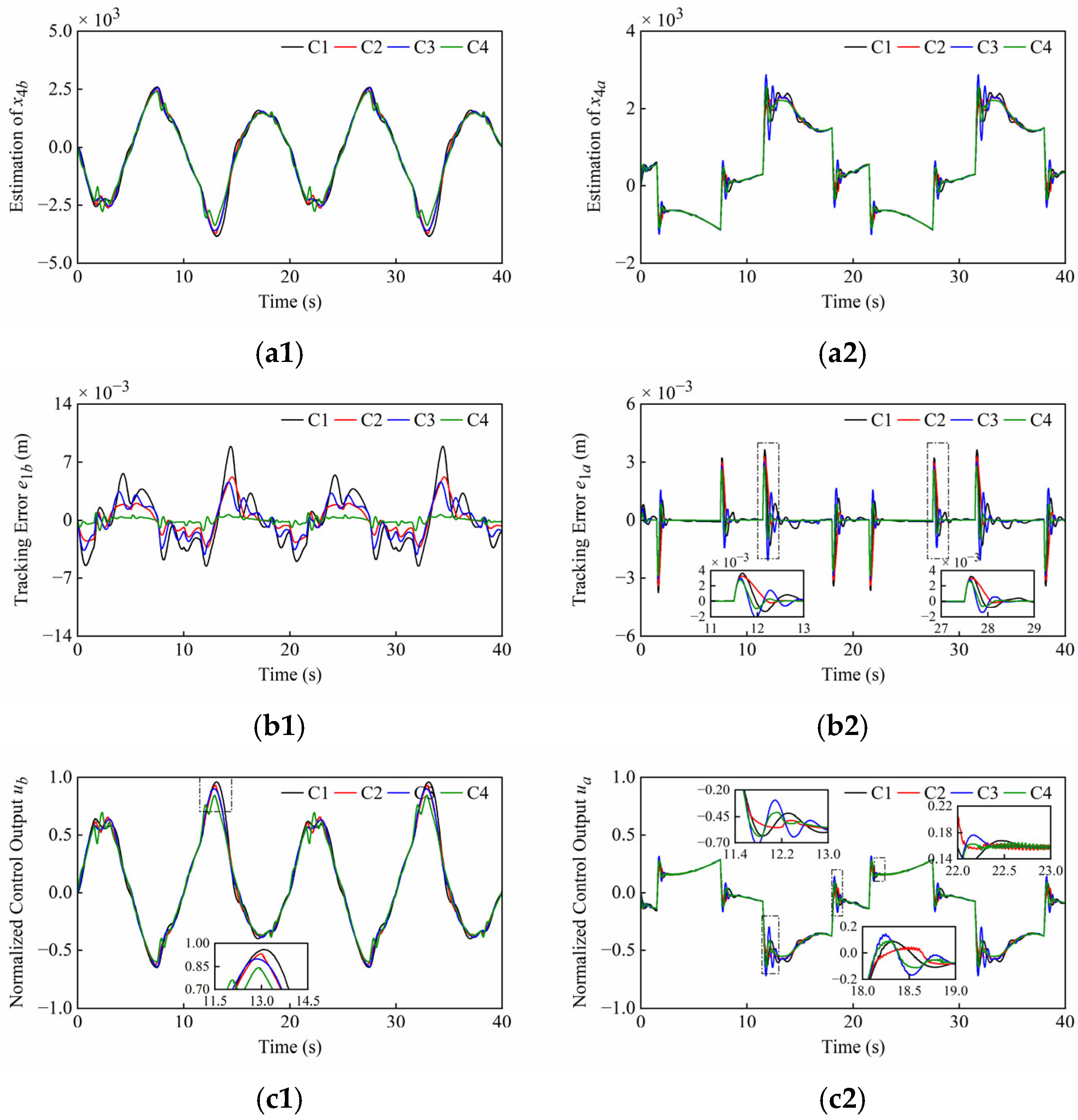3.1. ESO Design
Since the hydraulic cylinders used in practice are usually only installed with displacement sensors for the detection of the cylinder rod’s position, it is difficult to obtain the state information such as the actuator’s velocity and acceleration directly through components, and the system disturbances cannot be accurately estimated and effectively suppressed. Therefore, ESO is designed to address the above issues.
The constant gain
bn is used instead of the nonlinear gain
b in system (6). Defined
as the difference between
bn and
b. Then, (6) can be rewritten as
where
represents the lumped disturbances, which include unknowns, uncertainties, coupled dynamics and modeling errors. On the assumption that
δ is bounded and differentiable, define
x4 =
δ as the fourth system state. Then, the state vector
X is expressed in four-dimensional form, i.e.,
. The original system (7) is rewritten as
Defining the estimation vector of
as
, and a linear type of the ESO [
36] is designed as
where
ω0 is considered to be the observer bandwidth,
ω0 > 0.
Defined
as the error vector, and
as the constructed ESO error vector. Combining (8) and (9), the dynamic equation of the observation error is given as
where
,
and
.
The system matrix
A of (10) is Hurwitz. Thus, there exists a symmetrical positive definite matrix
P satisfying the following equation
Define the Lyapunov function of the observer as
, then the derivative of
Vo is given as
By the comparison lemma [
37], it can be inferred that the ESO in (9) is stable, while the convergence rate and observation accuracy are determined by the bandwidth
ω0.
3.2. ESO-Based Chattering-Free TSM Controller Design
Given
x1r as the position reference of the cylinder rod, the tracking error is defined as
Combining the system (7), the error dynamics can be expressed as
The chattering-free TSM manifold [
19] of the same order as the system (14) can be constructed as
where
βi (
i = 1, 2, 3) are selected such that the polynomial
is a Hurwitz polynomial.
σi (
i = 1, 2, 3) are given as follows [
17]
where
.
The estimated states are used to replace the actual states in the above equations, and (15) can be rewritten as
where
and
.
The control law is designed as
Let
s = 0 and substituting the estimated disturbance
into the control law for feedforward compensation, and the equivalent control law
ueq is given as follows
The
un is obtained by a low-pass filter as follows
where
T ≥ 0 is a small constant.
The composite reaching law is chosen as
where
and
The Laplace transfer function of the filter (20) is
If
T = 0, the transfer function can be written as
The system (14) is chattering-free if the control output u is designed as (18). The reason is that the switch function in (21) is non-smooth, but un(t) in (18) is smoothed by the filter (20).
From (14), (18), (19) and (25), (15) can be simplified as follows
where
.
Derivation of (26) can be given as
Defining the Lyapunov function of the controller as
, combining (20), (21), (26) and (27), the derivative of
Vc can be given as
Then, substituting (29) into (28) yields
Applying the claim in [
38], the following can be obtained
where
is a constant, and
.
To ensure that the system (14) is stable, the parameters in (21) and (22) are chosen as follows
Substituting (22) and (31) into (30) yields
Considering the closed-loop system formed by the observer and the controller together, the Lyapunov function is expressed as
. From (12) and (33), the derivative of
V can be written as
where
and
.
Applying the comparison lemma [
37] for inequality (34) yields
Thus, the function V is bounded by , which means the closed-loop system is stable. If K, kg and ω0 are sufficiently large, while ε is sufficiently small, the function V tends to be zero in finite-time.
Equations (9) and (18)–(22) show the complete structure of the proposed ESO-CFTSM in
Figure 3, and the parameters to be tuned are as follows: (
bn, ω
0,
β1,
β2,
β3,
σ,
T,
K,
kg,
ε). First of all, the ω
0 and
bn in the ESO (9) should be set. The ω
0 can be tuned with a simple proportional controller to obtain the desired estimation performance. Furthermore, as the
has already been observed and compensated for within the lumped disturbance
x4, the accuracy of the
bn is not a primary concern. However, it should be noted that the
bn determines the control gain in (18). Regarding the parameters
β1,
β2,
β3, and
σ in (15), a smaller fractional power
σ can provide the system with a faster convergence rate near the equilibrium point. Once
σ has been selected,
β1,
β2 and
β3 can be tuned with the pole placement method to achieve the desired system dynamics. In (21), the
ε in the nonlinear term is set to a small value to reasonably approximate the sign function, and the nonlinear gain
K enhances control robustness. The
kg in the linear term ensures fast convergence towards the sliding mode when the function
s (15) is large. A sufficiently small T can filter out all high-frequency noise caused by the switching function.
It is worth pointing out that the parameters bn, T, K, kg and ε can be easily set. At the same time, a σ closer to 0, a larger observer bandwidth ω0 and larger gains βi (i = 1, 2, 3) can achieve the faster response and the higher accuracy, but unreasonable values will cause the system to over-respond and amplify high-frequency noise. Therefore, in practical applications, the parameters tuning of both the observer and controller are subject to factors such as measurement noise, the specified sampling rate, and system dynamics. A trade-off between different parameters must be made to achieve optimal control performance.
